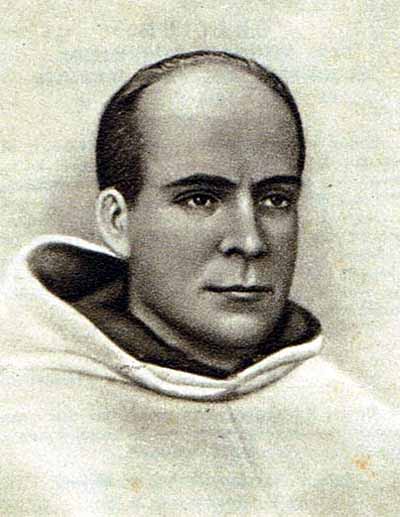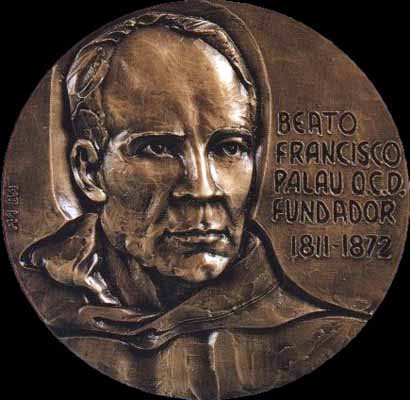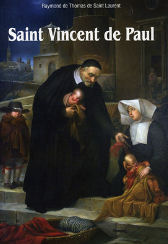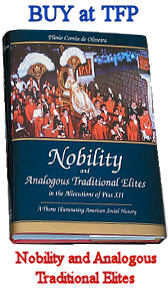Born December 29, 1811, in Aitona, Lleida, Spain
Died 20 March 1872, in Tarragona, Spain
Beatified April 24, 1988
Feast November 7
Discalced Carmelite Spanish priest. He founded “The School of the Virtue” — which was a model of catechetical teaching for adult persons—at Barcelona. In 1860-61, he also founded a mixed Congregation of Third Order of Discalced Carmelites, both Brothers and Sisters, in Balearic Islands. He preached popular missions and spread veneration of Our Lady wherever he went. Francisco Palau understood the beauty of the Church. What had been a confusing oscillation from solitude to service and back to solitude again made sense for him when he recognised that the real Church is the congregation of humans in the whole Christ. God and neighbours together, is his Beloved.
Early life
He was born on December 29, 1811 in Aytona, Lerida, Spain. He was 7th of the nine children of Jose Palau and Maria Antonia Quer. He was baptized on the same day according to the family tradition and the custom in the country.
The year he was born was a year of hunger and life became harder because of the French invasion has reached the village of Aytona. They were a humble family who worked in the farm. After a day’s labor, they used to gather together to pray the rosary.
They were actively involved in the parish life. His father and all of his siblings, including himself, were members of the choir and fervent in the reception of the sacraments.
He studied at the town school and through the help of his sister Rosa, he pursued higher education.
At 14, he decided to become a priest. He frequented the seminary classes first, as a day pupil.
At Lerida, he finally entered the diocesan seminary on October 1828. For four years, he was granted a “Porcionista” scholarship which means he was a full scholar with free board and lodging.
In 1832, he formally relinquished his scholarship to enter postulant at the Discalced Carmelites convent of Lérida.
Discalced Carmelite
He entered Barcelona Carmel on October 23, 1832 as a novice. On November 14, 1832, he was given his habit and took the religious name “Fr. Francisco of Jesus, Mary, and Joseph”. Francisco professed solemnly on November 15, 1833—it was a time when religious persecution was beginning in Spain. He was aware of the situation but courageous, and he never retracted his option. He continued his studies of theology in the Convent of San Jose in Barcelona.
On July 25, 1835, convents and monasteries in Barcelona were vandalized and burned. The San Jose Convent was one of those burned down. Looking after others, he helped the ancient friars to get safely out of fire.
Apostle and founder
He continued his life of asceticism in his hometown where he alternated solitude and apostolic activities, living in a cave situated 2 km from the village. He was ordained priest in Barbastro, Spain on April 2, 1836.
His first charge was as an Apostolic Missionary because of his great spirituality and apostolic activity in the dioceses of Cataluna and Aragon.
Since the government looked with suspicion on all the priests and clerics, on July 21, 1840, even if he never mingled really in politics,Fr. Palau was obliged to cross the Pyrenees to live in exile in France for eleven years up to April 1851. There he continued to live his solitary life in the castle of Montdesir, Livron, and then in Cantayrac. During his last years staying there, his form of living, shocking for many people, drew the attention of the civil and ecclesiastical authorities. To defend himself, he wrote: La Vida Solitaria (The Solitary Life) and El solitario de Cantayrac (The loner).
He returned to Spain on April 13, 1851. He became the spiritual director of the local seminarians in Barcelona. At the same time he organized the School of Virtue in the Parish Church of San Agustin with its weekly Sunday school for adults, (1851–1854), based on the virtues from the Catecismo de las Virtudes (Catechism of Virtues) and with a programme of 52 propositions on the current ideological movements. The liberals in power protested against the school. As a consequence, it was suppressed and Fr. Palau was confined in Ibiza for six years (1854–1860).
He remained banished for 6 years. He found an islet, a towering rock, El Vedra, near Ibiza and, needing solitude, he used to retire and pray there seeking God’s will. He established a hermitage in Es Cubells where he enthroned the image of Our Lady of the Virtues, establishing the first Marian sanctuary on the island, and promoting devotion to the Blessed Virgin Mary among the islanders.
In 1860–1861, he reorganized the hermits of San Honorato de Randa in Mallorca and initiated the foundation of a Carmelite family – the Congregation – Third Order of Discalced Carmelites of the Congregation of Spain.
He started to write Mis Relaciones Con la Iglesia (My Relations With the Church), a sort of autobiographical journal, partly written in the idyllic solitude of El Vedra, transmitting his experience of the Church conceived as God and neighbors.
He was authorized and nominated Founder and Director of the Carmelite Tertiaries of Spain in 1867. In 1868, he initiated in Barcelona the weekly publication of El Ermitano (The Hermit). He assisted the sick and he practiced exorcism. He even created a project for a religious order exclusively in order to exorcise.
While fully immersed in his apostolic and foundational work, he was infected as he helped the sick at Calasanz, reaching Tarragona, Spain on March 10, 1872, he died on March 20, 1872 at 60 years of age assisted by the Sisters.
After the Spanish Civil War that ended in 1939, Little Brothers who survived were incorporated into the Teresian Carmel. The sisters are now flourishing in two congregations: Teresian Carmelite Missionaries and Carmelite Missionaries.





















